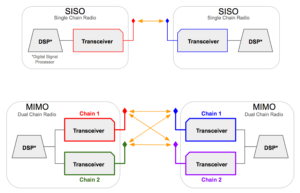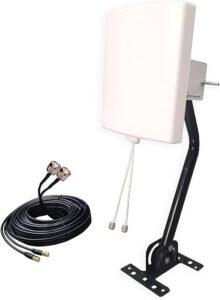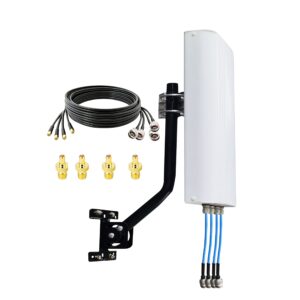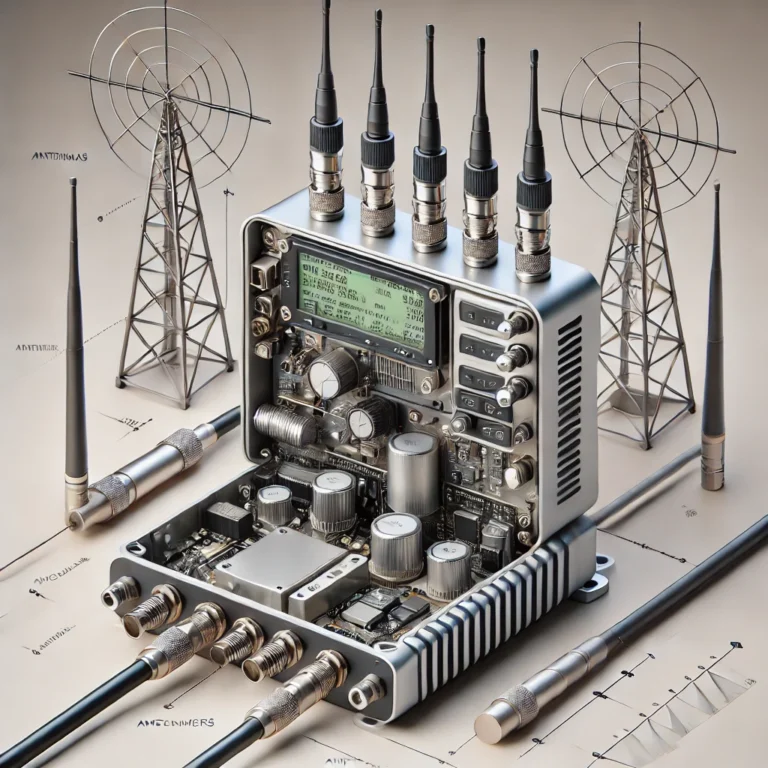What is a MIMO antenna?
In today’s fast-paced, data-driven world, MIMO (Multiple-Input, Multiple-Output) antennas have emerged as a transformative technology in wireless communication. Unlike traditional antennas, MIMO systems leverage multiple antennas to manage multiple signal paths simultaneously. This multi-path approach enhances data transfer speeds and boosts signal quality, making MIMO antennas indispensable in technologies such as 4G LTE, 5G NR, Wi-Fi 5, and the latest Wi-Fi 6/6E standards.
To simplify, think of a MIMO antenna as a collaborative team. While a single worker (or a traditional single-input single-output antenna) might struggle to complete all tasks alone, a team of workers (the MIMO elements) divides the workload. This teamwork ensures faster and more efficient communication, creating a robust and reliable connection.
MIMO vs. Single Antenna: A Comparative Overview
When considering an antenna for your network, you’ll likely encounter two main types: MIMO and SISO (Single Input, Single Output). Understanding the differences between them is crucial for choosing the right solution for your needs.
- MIMO Antennas: Equipped with multiple transmitters and receivers, MIMO antennas simultaneously handle multiple data streams. This capability translates to faster speeds, superior signal quality, and better performance in challenging environments with interference or weak signals.
- SISO antennas: Featuring just one transmitter and one receiver, SISO systems can only handle one data stream at a time. This limitation affects speed and reliability, particularly in situations with high data demand or signal congestion.

Performance Boost with MIMO: Transitioning from SISO to a 2×2 MIMO system increases connection speeds by approximately 30%. Upgrading further to a 4×4 MIMO setup can yield a 70% improvement, even in congested network conditions. This efficiency stems from MIMO’s ability to send more data using the same spectrum of resources.
Deciding Between SISO, 2×2 MIMO, and 4×4 MIMO
Your choice of antenna depends on your device and specific connectivity requirements.
- SISO Systems: Suitable for basic tasks like light browsing, where high speed and reliability aren’t critical.
- 2×2 MIMO: Ideal for standard consumer devices, offering a balance of performance and cost. It’s commonly found in Wi-Fi routers and entry-level 5G devices.
- 4×4 MIMO: Designed for high-performance environments, this system is perfect for advanced 5G devices or high-end routers. It delivers unmatched speed and reliability, making it the go-to choice for gamers, streamers, and smart homes.
The Compatibility Factor: Matching MIMO to Your Device
It’s essential to match your antenna type to your device’s capabilities. For instance, using a 2×2 MIMO antenna with a device that supports 4×4 MIMO can lead to incomplete coverage of frequencies, as not all ports broadcast the same signals. For optimal performance:
- Pair 2×2 MIMO antennas with devices having two antenna ports.
- Use 4×4 MIMO antennas for devices with four external ports to maximise frequency utilisation and speed.
Exploring 2×2 and 4×4 MIMO Configurations
MIMO configurations are denoted by the number of transmitters and receivers they employ, such as 2×2 or 4×4. Here’s what they mean and where they excel:
- 2×2 MIMO: This setup includes two transmitters and two receivers. Often cross-polarised (arranged in an “X” or “+” formation for better isolation), 2×2 MIMO can handle two concurrent data streams. It’s a reliable choice for most consumer-grade routers and mid-tier mobile devices, offering a 30% performance boost over SISO systems.
- 4×4 MIMO: incorporating four transmitters and four receivers, 4×4 MIMO supports up to four spatially multiplexed data streams. This configuration delivers an additional 30% increase in speed compared to 2×2 MIMO. Found in high-end Wi-Fi routers and advanced 5G devices, it’s ideal for environments requiring robust connectivity and high data throughput.


Choosing Between 2×2 and 4×4 MIMO: Always match your antenna choice with your device’s supported configuration. For instance, investing in a 4×4 MIMO antenna for a device that only supports 2×2 MIMO won’t unlock its full potential and may lead to underutilisation of certain frequency bands.
Key Takeaways: Why MIMO is the Future
MIMO antennas are redefining wireless connectivity by enabling faster speeds, improved reliability, and better handling of interference. Whether you’re setting up a home network, upgrading your smart devices, or optimising for 5G, understanding the differences between SISO and MIMO systems—and selecting the right configuration—can dramatically enhance your experience. For a seamless, high-performance connection, MIMO antennas are not just an upgrade—they’re a necessity.


